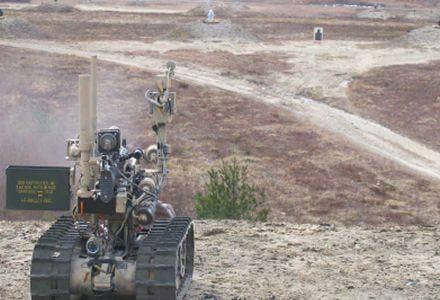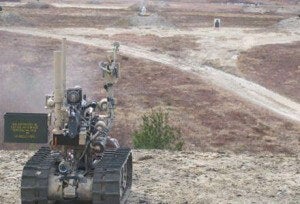The Present and Future of Military – Talon Robot (Video)

Share

Expendable. It's a word that is rapidly disappearing from use when describing soldiers in the field. Instead, that label has fallen on the shoulders of the newest unit in armed forces: the robot. Drones, remote operated vehicles, automated turrets...the mechanization of war is rapidly spreading, and changing the face of the front line. War 2.0, the next generation of armed conflict, is going to be filled with many different robotic systems. One such system, the Talon platform, has already demonstrated its varied effectiveness in the field. Like an average grunt, the Talon robots are called on to perform a wide range of duties, from surveillance to armed combat. While it's not the only successful robot series, the Talon platform demonstrates how versatile and attractive robotic warfare will be to the military leaders of tomorrow. We have a string of Talon videos below, make sure to check them out.
Back in 2000, during the US military action in Bosnia, some of the first Talon robots were deployed to help remove enemy explosives. Today, there are hundreds of the Talon Explosive Ordinance Disposal (EOD) robots in Iraq and Afghanistan. In less than a decade, the Talon EOD has gone from trial runs to a mission critical role in the US military strategy. This rapid shift in the war paradigm is mirrored in the Predator drones and CRAM turrets which have a major presence in the region. It appears that the modern military's response to asymmetric warfare is to adopt a different kind of asymmetry: 'our' robots versus 'their' humans. That's a scary, remarkable, and game-changing shift in war.
The Talon platform was developed originally by US company Foster-Miller, but has since been bought out and continued by the North American branch of the UK's Qinetiq. There are four major sizes of Talon: the smallest (15 to 50 lbs) Dragon Runner, the larger Talon (80 to 100 lbs), the weaponized SWORDS/MAARS (200 to 400 lb), and the small vehicle sized TAGS-CX (5,000-6,000 lbs). Each comes equipped with a variety of sensors, primarily 3-4 video cameras with night vision, zoom, and thermal imaging. A digital control unit (DCU) allows a soldier to remotely operate the robot using a joystick. For those military personnel who grew up playing video games, the DCU is a natural use of their arcade developed talents.
Taking Lives...
While the Talon EOD has seen the most use as it deals with IEDs and other roadside bombs, the Sword model has gotten a good deal of press. Why? Because it's packing heat. The SWORDS (now being replaced by MAARS) and similar models are lightweight enough to be carried and deployed by soldiers, and can be armed with a variety of ordinance from rifles to anti-tank missiles. They are also fast enough to keep pace with running soldiers, and can be operated up to half a mile (~1km) away for hours at a time (up to 8.5 hours depending on model). The following video demonstrates how the SWORDS Talon (and related TRAP Talon) could augment or replace front line human troops in combat.
...Saving Lives...
The lethality of these robots is indisputable, and some SWORDS Talon robots have already been tested in Iraq to varied success. Yet, as ubiquitous as armed robots may one day be, it's important to remember that the majority of Talons used today serve to save lives by disarming explosives. The Talon EOD has been used to great effect in the US' wars in the Middle East but it's also become an important tool for some domestic law enforcement agencies. The first video that follows demonstrates the raw destructive power that the Talon faces in the place of a human soldier. The second video highlights how the robot has been adapted to domestic use.
...Changing Perceptions
These videos show the range of the Talon platform, but the trend towards robotic warfare is larger than any one system. Robotic machines are having an impact at every level of the US Armed forces, from grunts to generals. Soldiers are becoming comfortable and trusting of their robotic tools, using them for play as well as work. The US Army is also actively leveraging robots, and the allure of cutting-edge technology, in its recruitment strategy.
Be Part of the Future
Sign up to receive top stories about groundbreaking technologies and visionary thinkers from SingularityHub.


(Talon appears at the end of the commercial)
As we've discussed previously in our articles on War 2.0, humans are unlikely to be completely removed from warfare, but they are being slowly moved away from the front line combat. With a human operator and robotic platform the military gains the best of both worlds: reliable decision making, and an expendable/repairable unit. If you boiled down conventional military strategy it may eventually be summarized as "make sure more of them die than us." The allure of robots in combat is that the 'us' can't really die.
That being said, military strategy is rapidly shifting away from the conventional. As alarming as armed robots may be to some, the truth is that all forms of lethal combat are losing situations. War isn't just becoming mechanized, it's changing battlefields. The asymmetric conflicts of tomorrow may be solved by pinpoint operations to kill, arrest, or detain opposition leaders rather than pit soldiers against one another in the field.
But until that time arrives, conventional warfare will dominate armed conflicts around the world. Robots, expendable repairable and versatile, are the natural successors to humans in such battles. The Talon platform, and similar systems from competitors, will continue to see increased use as the US military (and others) seek to accomplish their goals with the fewest casualties possible.
Of course, finding non-military solutions to conflict could alleviate the need for any casualties, but I doubt there's a robot in the world advanced enough to make that happen. ...ASIMO?
[photo credit: Qinetiq North America]
[video credits: Qinetiq, Foster-Miller, Military Channel, History Channel, RobotoBlog, Sempermc88 (via YouTube), US Army]
Related Articles

These Robots Are the Size of Single Cells and Cost Just a Penny Apiece

In Wild Experiment, Surgeon Uses Robot to Remove Blood Clot in Brain 4,000 Miles Away

A Squishy New Robotic ‘Eye’ Automatically Focuses Like Our Own
What we’re reading